Ideas
You know you have an amazing family when...
10/09/17 10:16
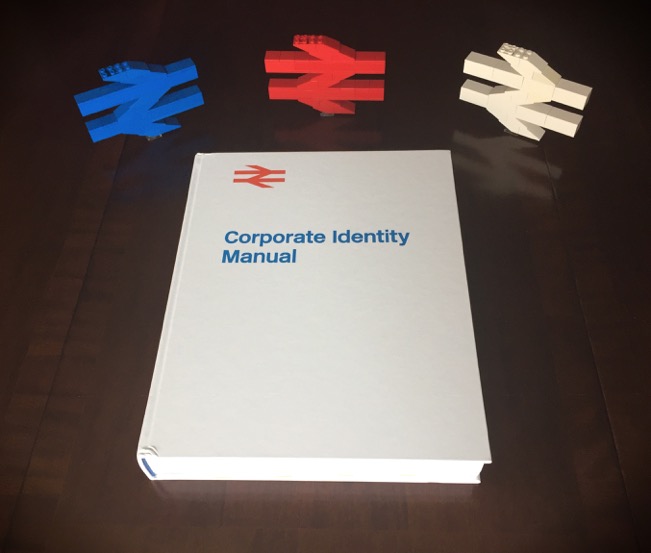
A couple of weeks ago, I finally received my birthday present in the post from my wife: a gorgeous reprint of the British Rail Corporate Identity Manual.
On my birthday itself, my eldest son presented me with brick-built BR double arrow logos! I can't believe that I hadn't thought of making them myself. In any case, I doubt I could do better than his brilliant builds. I think he perfectly captured their size and proportion in an elegant and clean stud-ups design.
The BR identity manual is a feast for the eyes, especially for train and graphic design geeks such as myself. Its lovely to see many similar identity manuals of this era being re-issued through the magic of crowd funding projects. Examples include the NYC subway, the EPA, IBM, and other public and private sector agency identity manuals being lovingly reproduced for posterity. Its a pity that the same care and attention to quality public branding and imagery is not often found these days. Not every logo or brand needs to become a design icon; however, it would be nice to simply avoid the garish self-indulgence of the latest trendy design fads (I'm looking at you Xerox and others who embraced trendy 3D-swooshy logos!)
I couldn't have asked for better presents as these. Sometimes love can be expressed in the purity of a logo! (and not necessarily a heart-shaped one!)
A Few of my Favourite Books
30/03/16 14:18
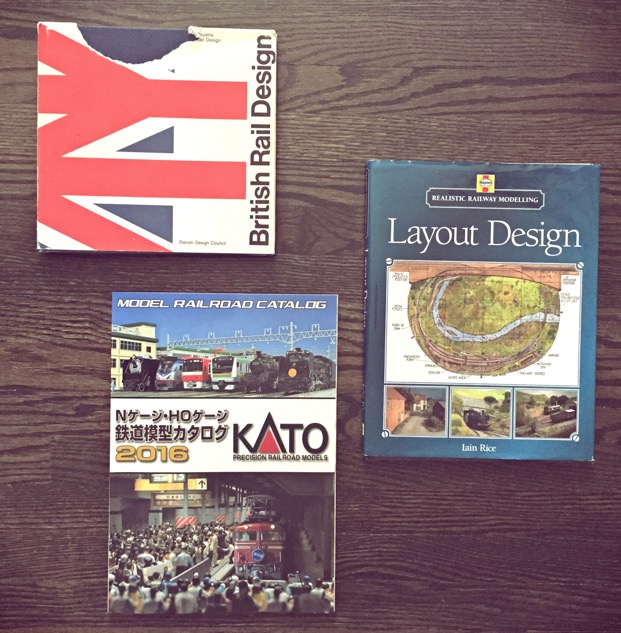
There's an active thread on Eurobricks discussing the possibility of relaunching a Lego train magazine publication following the demise of the excellent Railbricks.
I posted my opinions on this topic to essentially say that whilst I'd love a Railbricks replacement, there probably isn't a commercially viable way to make it happen.
It also got me thinking about what I loved about Railbricks and other great model train publications for that matter. The common factor was aspiration. By seeing a showcase of the very best models and layouts, inspired me to push my limits and to have the confidence to do so.
Shown above are three publications which inspire me in pursuit of this hobby in very different ways.
1) British Rail Design by James Cousins
Ironically published by the Danish Design Council, this book satisfies both my love of British trains and graphic design. It chronicles the radical impact of British Rail's rebranding strategy of the 1960s and how many elements of it survive to this day. This was an extremely difficult publication to find since it was long out of print. I heard of one copy being available in a Tokyo bookshop and one torn copy available from a Danish museum. (Obviously I got the torn copy from Denmark!)
2) Layout Design by Iain Rice
Iain Rice is no stranger to the UK model train community; having published many books and magazine articles on fine scale modelling. His approachable and witty writing style combined with uncompromising practical advice offered no end of inspiration to my scale modelling efforts. This book focuses on the topic of layout design. Everything from research, planning, operation, visual design, and much more are covered. What really strikes me about this book is how relevant it's content is to any model train scale and standard (including Lego!) Iain Rice has also published articles on layout design in the US Model Railroader magazine, so his name might be familiar to some US based modellers too.
3) 2016 Kato Model Railroad Catalog
Its not because I have a soft spot for Japanese N-gauge modelling, but I simply love this book! Or should I say catalog? At 258 pages it qualifies as a book! Even though I can't read most of it; I derive no end of inspiration. It shows how mind-bogglingly comprehensive a product line can be made and organized. Kato offers its lucky customers a complete "candy store" of products all designed to work together. Everything from baseboards, track systems, scenery, buildings, infrastructure, control, and yes the trains themselves! They offer a complete range of spares and conversion parts as well as practical how-to guides. It is expertly photographed with superb visual design. It is a fantasy version of what we would all love to have available in our niche Lego train hobby. It evokes the nostalgia of the relatively rich product range of the 12V Train era. And, it inspires me to offer a similar "product" range at L-Gauge.org. A range which is systematic, organized, and accessible to everyone.
Happy reading!
Train Chassis Testbed
02/03/15 20:33
As part of my on-going experiments into alternative Lego train chassis and drive-train arrangements, I totally stripped down and rebuilt my GO Transit F59PH locomotive as a "technology testbed". The body was completely redesigned to be separate from the chassis and to mount to its chassis "clam-shell" style like scale model trains. This allows me to develop and iterate the chassis design independent of the locomotive. I intend to use this configuration for all my locomotives in future because I like the idea of being able to perform maintenance and tuning without a traumatic disassembly and rebuild of the entire locomotive. In fact, I hope to be able to interchange chassis among some locomotives with similar wheelbase for flexibility. I hope to be able to keep all of the mechanical and electrical infrastructure (controller, battery, motor, lights, etc.) mounted to the chassis with minimal connection to the body shell.
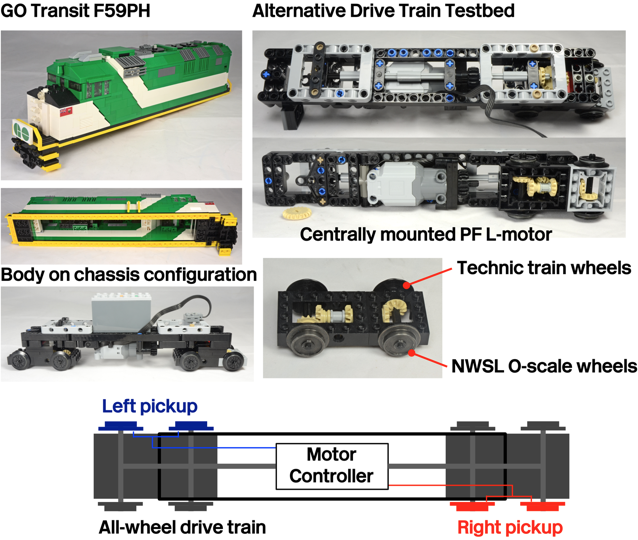
Illustrated above is some of the progress made to date. I have rebuilt the F59PH body shell--its still not finished, but very close. The chassis is my 3rd version built to date. It is powered from a centrally under-mounted PF L-motor. This keeps the centre of gravity lower and allows for more room inside the body shell. The motor drives a central drive shaft connected to gear driven 2-axle bogies. The tractive effort of this arrangement is impressive, especially with the L-motor vs. the M-motor.
The next steps will be to develop a power pickup from the metal wheels and to fabricate and develop my hybrid DCC + PF electronic control module. Lots to do, but its great fun!

Illustrated above is some of the progress made to date. I have rebuilt the F59PH body shell--its still not finished, but very close. The chassis is my 3rd version built to date. It is powered from a centrally under-mounted PF L-motor. This keeps the centre of gravity lower and allows for more room inside the body shell. The motor drives a central drive shaft connected to gear driven 2-axle bogies. The tractive effort of this arrangement is impressive, especially with the L-motor vs. the M-motor.
The next steps will be to develop a power pickup from the metal wheels and to fabricate and develop my hybrid DCC + PF electronic control module. Lots to do, but its great fun!
New Concept for Train Control
26/02/15 10:21
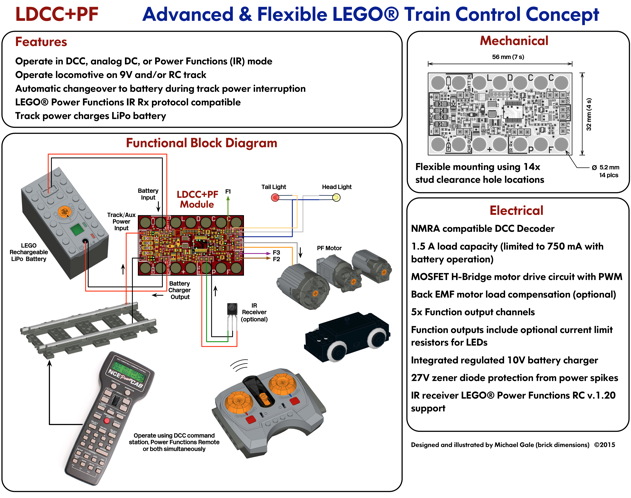
I have been struggling with the issue of controlling Lego trains for quite some time. My layout has been built for operation with metal track and NMRA DCC control and my locomotives have been converted to run with DCC decoders attached to 9V motor bogies. However, I am worried about the future of 9V track/motors and have been bothered with the lack of performance of the 9V motor bogie.
Here are a few issues that I've been thinking about:
1) POWER - the 9V motor bogie is relatively weak and often a train requires 2x or more for sufficient traction
2) HYBRID DRIVE - I love not having to worry about batteries when operating my layout at a show. However, I like the flexibility of battery operation and for running on plastic track.
3) TECHNIC/PF CHASSIS - I have developed a few prototype locomotives where the chassis and body are completely separate. The chassis is mostly built from technic elements with an all-wheel drive train powered from a centrally located PF motor. The chassis is nominally 5-studs wide to allow for a 7-stud wide body. The all-wheel drive chassis I have built have amazing tractive effort--easily better than any 9V powered locomotive. They do run a bit slower, but its a prototypical speed which I prefer.
What you see illustrated above is a prototype electronic control module (which I have called LDCC+PF) which attempts to address some of the issues of train control. Effectively its a DCC decoder at its core. Unlike a DCC decoder it includes a battery/power management function and an IR receiver. Also, mechanically it is designed to fit with stud and/or technic pin attachments. This module attempts to combine the best features of DCC and Lego Power Functions. The goal is to have reliable, powerful, and flexible locomotive operation.
The idea is that the motor is always controlled using a smart DCC decoder. It will take commands from DCC encoded packets on the track and/or commands from the PF IR remote. It will extend the functionality of the PF remote by allowing for DCC standard 14/28/128 speed steps and interpreting button presses+channel selection for function control. In some ways, you could consider this module a functional replacement for the Lego PF IR receiver (obviously with tons of additional functionality!)
So far I have more-or-less completed the electrical design and printed circuit board (PCB) (shown below). I have fabricated the prototype PCBs and they are currently being tested. I have made a preliminary start on the firmware for the module's micro controller--but this will take a great deal of time. I do have a bit of a head start since I have based the DCC decoder design on MERG's DEC12 decoder. I am implementing totally new firmware on a different micro controller than the MERG design written in C rather than assembler. I also have to implement all of the Lego PF IR protocol in addition to the DCC.
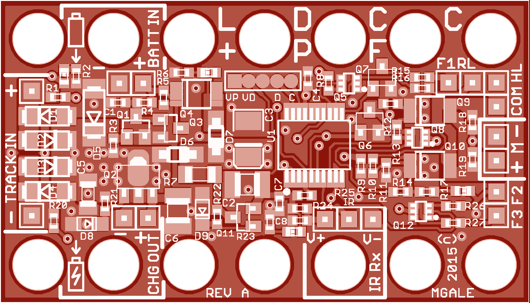
I hope this experiment turns out--I do look forward to my ambition of a hybrid-drive train chassis!